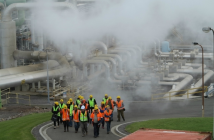Two fatal accidents and several serious incident investigations by WorkSafe’s High Hazard Unit provide valuable lessons to prevent mobile plant unintentionally entering water.

The first fatality occurred when a mine worker was checking a pump at night at an unlit settling pond and suffered a medical event.
His 4WD vehicle entered the pond and overturned.
Two of his children were in the vehicle and one died.
A second fatality happened when a riverside extraction quarry worker that operates on both sides of the river attempted to ford the river in his own vehicle.
It was in darkness in the early morning.
Recent rain meant river levels were higher than normal.
It appears that the worker’s vehicle was swept downstream by the current, trapping him in his vehicle and he drowned.
Near miss
Meanwhile, a mine worker had a near miss when he was operating a bulldozer to construct a ramp from one mine level to another.
After completing the ramp, he decided to place a bund around the sump.
He tested the sump depth by placing the blade into it.
He thought the sump was shallow and backed the bulldozer into the sump to clean it out.
However, in the test the blade had rested on the sump side not the bottom, and the bulldozer ended up partially submerged.
Close call
Similarly, a mine supervisor, excavator operator and an electrician had a close call when they began moving an electric pump to deal with very high water in the mine sump.
The operator attached the pump and pontoon to the excavator’s lifting eye with the supervisor holding the cables clear of the digger acting as spotter.
As the operator was about to position the pump, the safety berm and bank gave way and the digger slipped into the water.
The high water level had decreased the ramp’s stability and the sides collapsed with the excavator’s weight on its edge.
The supervisor slipped towards the water but managed to find his footing and got clear of excavator.
The digger operator managed to climb through a side window of the vehicle.
Slippery slope
Another near miss resulted from an excavator loading trucks with sump slops for the working shift.
Whilst waiting for trucks, its excavator operator had been sidecasting pond material.
During this process the excavator slipped sideways on solid rock into the pond.
The operator tried to correct the slipping by pushing back on his bucket.
This action tipped the excavator sideways into the pond.
The excavator cab was partly submerged in water.
The operator exited the machine cab via its rear window.
Dangerous detour
Another fatality was narrowly avoided when a mine worker moving an excavator between two sites encountered a road closure on the normal access route.
He decided to detour across a pond division wall.
Smaller excavators had traversed it on previous occasions.
When the excavator was halfway across, the wall failed under the weight of the excavator causing it to tip sideways cab down in the water.
The worker was lucky to escape as the cab was almost submerged.
Finally, a quarry worker operating a long Reach Komatsu PC200 excavator was tasked with clearing slurry from a pond at a sand quay.
The worker emptied his bucket and was slewing left, when the ground under the excavator gave way, causing it to slowly topple into the pond.
The worker was helped out of the excavator by other workers.
As these events demonstrate, working near water or soft ground presents a significant risk to workers. The ground, known as a work platform, should be designed or assessed so that the effects of water on it are understood.
What can be learned from these incidents?
- Mine and quarry operators should include checking wind rows around water sources to ensure they are adequate to prevent vehicles entering the water.
- Wind rows must be designed, constructed, installed and of sufficient height to offer definite restraint in the event a vehicle accidentally contacts them.
- Operations that use fords to connect work areas should carefully assess the risks and develop rules when conditions change.
- Before any excavation, an appraisal of ground conditions should be undertaken by a competent person to determine all factors likely to affect ground stability, and any limitations that should be imposed on excavation design. Such appraisals or assessments should be reviewed and revised where necessary when a material change has occurred in the ground conditions or the excavation methods change. For example, if water has access to material, especially if it’s crushed, this will decrease the material’s strength.
- Effective ground control relies on geotechnical information obtained throughout the life-cycle of the site:
- during planning and design
- at design implementation and
- through day-to-day operations.
- Following ground conditions appraisal, a design should be prepared setting out measures to control ground instability.
- Where an existing design has already been proved, it may be used as the basis for new excavation design, where the ground conditions at both sites are similar.
- Edge protection, barriers, warning signs and other suitable controls should be placed around any water filled excavation to keep people away from hazardous zones. These controls should be moved as the excavation progresses and hazardous area changes.
- The installing of bunds around water and use of lighting rigs for night work are essential for safety.
- Rescue facilities must be provided, and may include equipping mobile plant with features or tools for emergency use, for example, push-out windows or window breaking tools.




